The New Motorola Moto X (2nd Gen) Review
by Joshua Ho on September 17, 2014 9:00 AM EST- Posted in
- Smartphones
- Motorola
- Android
- Mobile
Battery Life
Unlike most subjects that need significant explanation to justify the rigor of testing, battery life is something that everyone can appreciate. However, for those that are unfamiliar with our testing, we make it a goal to produce a repeatable, realistic test. In order to do this, our web browsing test runs a loop of webpages that ensures all power states with the screen on are properly represented in the test. In order to control for extraneous variables we standardize display brightness to 200 nits with strong signal.
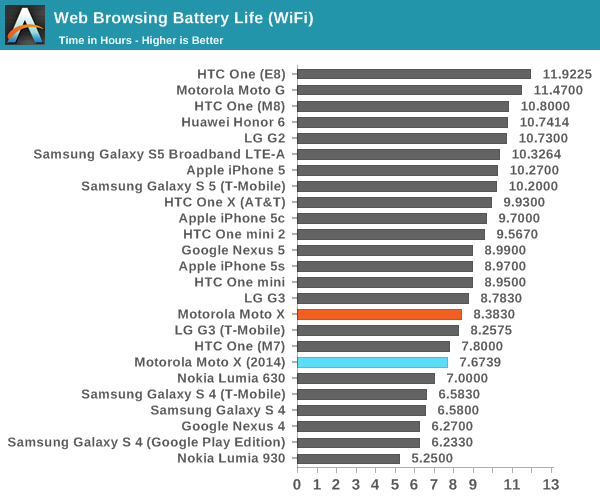
When running the web browsing test on WiFi, we see that the new Moto X manages to regress in battery life from the previous Moto X. This is a bit of an expected result as only the newer process of the SoC and new display technology can offset the decrease in battery size. In the LTE comparison there's a great deal more complexity as the previous Moto X had a less power efficient modem and RF front-end. The new Moto X has the same WiFi chipset as the previous Moto X, which is Qualcomm's WCN3680.
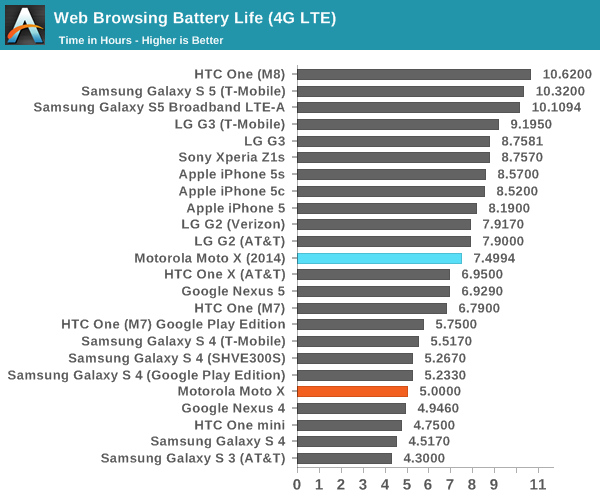
On LTE, the new Moto X is noticeably trailing behind the rest of the competition. Here we see that battery life is just behind the LG G2, but behind all recent Apple iPhones and just about every other Android high-end flagship phone launched in 2014. While the new Moto X has definitely improved over the previous Moto X, it seems that Motorola has used the newer AMOLED panel and lower power SoC to avoid using a significantly larger battery.
However, web browsing is not the only scenario worth testing. As the web browsing test is largely dominated by display power, it’s important that we test scenarios where all the other subsystems are more dominant in the power equation. For this, we turn to Basemark OS II and GFXBench 3.0, which focus more on CPU and GPU power consumption.
Unfortunately, I could not get our GFXBench rundown test to complete despite multiple attempts as it seems that the phone would either reboot or kill the application. Looking at the logs for the rundown test reveals that there’s no real change in FPS from run to run. After some extra investigation, it seems that this build (KXE21.187-43) doesn't do any throttling on GPU, so any workload that can keep the GPU at maximum heat output without dependence on CPU can cause the phone to reach unacceptable temperatures.
At any rate, the Basemark OS II run did complete so we can look at that.
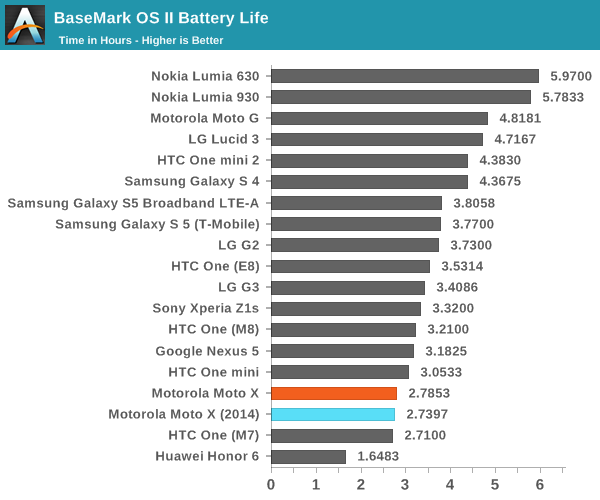
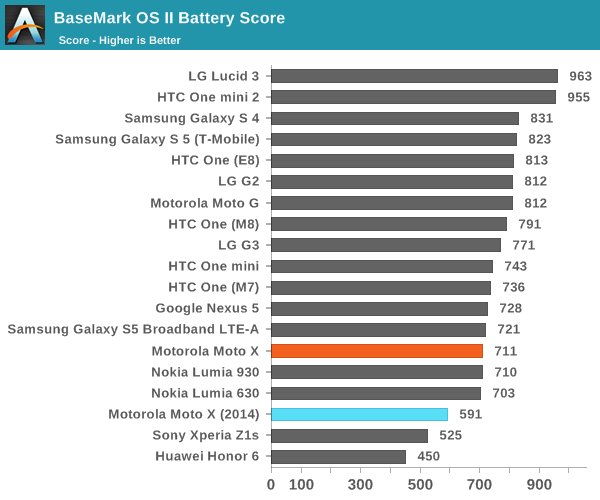
Unfortunately the Basemark OS II test reveals that battery life is poor compared to the competition. Normally, low battery life is compensated for by high performance but the battery score is only above the Sony Xperia Z1s and Huawei Honor 6, and the latter had no power budgeting mechanisms on the SoC to keep battery life at acceptable levels.
Overall, it’s hard to really say much in the way of praise for battery life. While it’s definitely surprising just how much battery life Motorola has achieved given the size of the battery and display, I suspect that Motorola found themselves in an uncomfortable situation as they tried to deliver a bigger display while keeping the phone easy to use with one hand. I suspect that all things considered, Motorola would have been better off if they went for a smaller display and the smaller height and width that would logically follow. It’s also not that the battery life is bad in an absolute sense, but it isn’t as good as its peers. Motorola is likely tracking closely to their estimated 24 hours of “mixed usage”. The use of Moto Display will also go a long way to reduce the time with the AP and display on.
Before I conclude this section, I just wanted to note that Android L alone won’t improve battery life on these tests. Android RunTime (ART) won’t help with battery life as these applications are native code. Job Scheduler is also irrelevant to our tests, as it will only improve battery life in situations where multiple applications are running in the background. We make every effort to ensure that no background tasks occur during these battery life tests and auto-sync is disabled as well in order to make sure that the only task running is the one under test. We have already run the data early in the summer on the Nexus 5 with Android L developer preview and our data does not show any significant difference in battery life. However, in real world usage where background applications and data syncing are active, one can expect greater battery life with Android L but only in the range of 10-15%.
Charge Time
While battery life from full charge to no charge is critical, in many situations the reverse is also important. For example, if one only has an hour before a flight, the rate at which the battery charges is just as important as the rate at which it discharges in use. In order to test this, the phone is connected to the included charger and the time from the battery begins charging to the time the charger stops drawing significant power is measured, as charging LEDs can often be an inaccurate method of determining charge time.
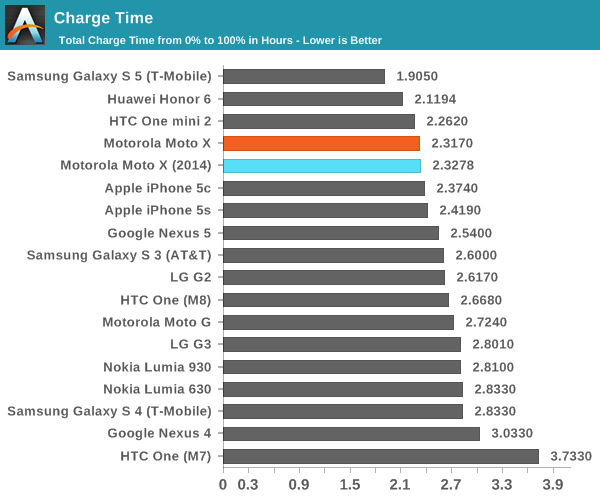
Motorola ends up on the high side here, which is somewhat expected due to the relatively small battery. I'm surprised that this is possible with a 5V, 1.15A charger though.


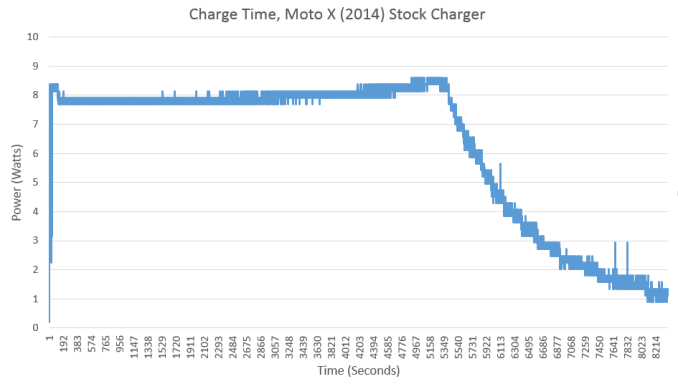








179 Comments
View All Comments
cknobman - Wednesday, September 17, 2014 - link
Hmmm.........Crap screen
Crap battery life
Crap camera
Why should anyone buy this again?
piroroadkill - Wednesday, September 17, 2014 - link
They won't.There were reasons to buy Moto X, but this new version is pointless, it's huge and worse than the alternatives.
soccerballtux - Thursday, September 18, 2014 - link
I don't understand what the hate is. I still think it's a great phone.gg555 - Wednesday, September 24, 2014 - link
I'd say it has a very good, but not top of the line screen. A passable camera. And okay battery life (bettery than many of last years phones), but again not top of the line for today's flagships. So your characterizations are unfair, I think.The Moto X does have a beautiful design, arguably one of the best out there, on a Par with the HTC One M8. It also has the active display, always on voice commands, and the hand gestures, which sound like they are very well developed features that add convenience (unlike the gimmicky heartrate crap on other phones).
It has basically stock Android, without a bunch of bloat software, which many people like. And this will also make it easy for it to get very quick updates to new version of the OS (all of Motorola's additions are downloadable as apps and do not require Motorola to spend a lot of time updating its skin, etc., for a new version of Android).
It also as a super sophisticated antenna design, as explained in the AnandTech preview of the phone a couple weeks ago. That ought to make it industry leading, if you know, you use your phone to connect to a network.
And it has a once of a kind four microphone noise cancellation solution. This is extremely unusual. The best noise cancellation chip out their (from Audience) has a three microphone option, but don't know of anyone who has even implemented that (if so it's very rare). Two microphones is the norm. So four microphones is exception. Unfortunately, AnandTech did not test it like they used to do. But it could make for incredible call clarity in noisy settings.
So the Moto X is certainly not necessarily for everyone. There are arguments to be made for other phones. But I think it holds it own, offers useable features, rather than gimmicks, and has a lower price than other flagships. It's a prefectly good choice. Other phones have their own shortcomings.
DeciusStrabo - Wednesday, September 17, 2014 - link
Man, that's sad to see all these regressions. I love my Moto X, could easily deal with the increased size and love to see the performance, but that battery life is simply embarassing. Worse than last years version? That's simply not acceptable. Worse screen in some respects and a camera that's somewhat better, but not really good doesn't help.I really was very close to ordering the new Moto X, but it seems I will have to wait at least until the new Nexus device, maybe even longer. Or - god forbid - think about an iPhone.
semo - Wednesday, September 17, 2014 - link
In this day and age, regression sells! I have no idea how but putting taking useful features away somehow generates more sales. It's also another chance to (re)introduce groundbreaking and amazing features at a later date!I think these days, if you are a phone manufacturer, all you have to do is make the screen bigger and you can take a massive dump on anything else. Better still, if you are a monitor manufacturer, just stick an LTE chip to one of your monitors and sell it as the best phone ever.
MrGutts - Wednesday, September 17, 2014 - link
Not to be a smart ass; well yeah I am going to be.Why in the world does someone want to invest money in a company that gets pass around like some prostitute on Saturday night? Who's turn is it this year, IBM was it?
The company doesn't communicate anything to the consumers, they horribly screwed a ton of customers on new phones telling them they are NOT upgrading the android OS on the phones. The list can go on with them.
DeciusStrabo - Wednesday, September 17, 2014 - link
Which phones don't get an update by Motorola?soccerballtux - Thursday, September 18, 2014 - link
The Atrix4G was marketed as the worlds most powerful phone, and never made it past Gingerbread even with its 1GB RAM and dual core processor.I still hate them for it
randomlinh - Wednesday, September 17, 2014 - link
Hrm, no T-Mobile LTE band 12... which is the newly acquired 700mhz VZW band I believe? Though, almost moot given how disappointing the battery life is.